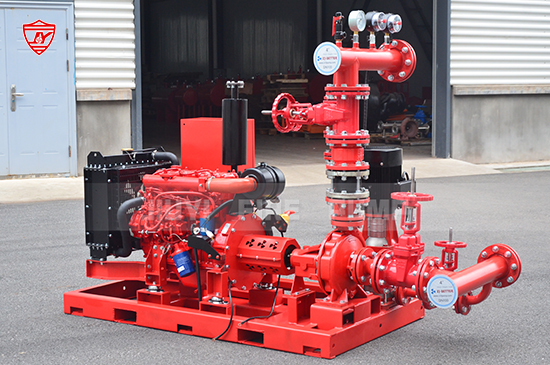In the world of fire protection systems, reliability is not a luxury—it’s a necessity. At the heart of many fire suppression systems are fire pumps, which must operate flawlessly when needed. One common yet serious issue that can impair performance or even lead to system failure is seal leakage. If not addressed early, seal leaks can cause downtime, system damage, and costly repairs. In this article, we’ll guide you through how to prevent seal leaks in fire pumps by addressing their causes, best practices, and preventive maintenance tips.

A seal leak in a fire pump refers to the unwanted escape of fluid (usually water or antifreeze mixtures) from the pump housing due to a failure in the mechanical seal system. Mechanical seals are crucial components that prevent pumped fluid from escaping into the environment or into the motor housing.
Seal leaks typically begin as minor drips but can escalate into major issues that compromise pump efficiency and safety. Understanding why seals fail is the first step toward preventing it.
Improper Installation
Incorrect alignment of the pump shaft during installation can create uneven pressure on the mechanical seal, leading to premature wear and leakage.
Dry Running
Fire pumps must always be primed with water before operation. Running a pump dry even for a few seconds can burn out the seal faces due to lack of lubrication.
Cavitation
When the pump doesn’t receive sufficient water (due to clogged filters or suction issues), vapor bubbles form and implode near the seal area, damaging the components.
Poor Material Compatibility
Seals must be made of materials compatible with the pumped fluid. For example, certain chemicals or antifreeze additives may degrade standard seal materials.
Thermal Shock
Rapid temperature changes, such as a cold pump receiving hot water instantly, can crack or warp the seal faces.
Excessive Vibration
Pump imbalance or motor misalignment causes vibration, which increases mechanical wear and loosens sealing surfaces.
Seal longevity begins with professional installation. Follow these key points:
Align the pump and motor shafts accurately.
Use laser alignment tools if possible.
Ensure the seal housing is clean and free of debris during assembly.
Use the correct torque when tightening fasteners.
Consider the fluid type, pressure, temperature, and operating environment:
Viton or EPDM seals are common for water-based systems.
Carbon/Silicon Carbide seal faces offer better wear resistance.
Avoid rubber seals in applications involving chemicals or high temperatures.
If your system includes additives or antifreeze, consult the seal manufacturer for compatibility.
Cavitation is a seal killer. Prevent it by:
Ensuring the suction pipe is the correct size and length.
Avoiding elbows or strainers too close to the pump inlet.
Keeping the water source (tank or main line) above the pump if possible.
Always prime your fire pump before starting. Air trapped in the pump can dry-run the seal.
Install automatic air release valves.
Include priming lines for pumps not self-priming (like vertical turbines).
Train staff to check water presence before operation.
Avoid thermal shock by:
Gradually introducing warm water into a cold pump.
Using pre-warming systems in cold climates.
Avoiding sudden pressure surges.
Install vibration monitoring or periodically check for:
Misalignment of motor and pump shaft.
Worn-out bearings.
Foundation settling or loose baseplates.
Early signs of vibration often precede seal failure, so proactive maintenance is crucial.
Make it a routine to inspect for:
Minor leaks (look for water trails or wet areas).
Excessive shaft movement.
Seal face wear (if visible during disassembly).
Mechanical seals depend on the pumped fluid for lubrication. If you’re using a pump with a stuffing box or additional lubrication system:
Ensure grease or oil reservoirs are topped up.
Replace any clogged lubrication ports.
Document the following:
Operating hours of the pump.
Service intervals.
Seal changes and their causes.
This helps track trends and forecast maintenance before failure occurs.
NFPA 25 (Standard for the Inspection, Testing, and Maintenance of Water-Based Fire Protection Systems) outlines routine inspections for fire pump systems. Your seal inspections should align with:
Weekly visual checks.
Annual teardown inspections if required by performance history.
Recording any leakage and taking immediate corrective action.
Replace seals if:
You notice persistent dripping or spraying.
There's visible scoring, pitting, or wear on the seal faces.
The shaft sleeve is corroded or grooved.
The pump experiences abnormal vibration or overheating.
Don’t wait until failure during an emergency test or, worse, an actual fire event. Replace early and document the service.
Cartridge Seals offer ease of installation and fewer alignment errors, making them ideal for fire pumps requiring reliability with minimal field adjustment.
Component Seals may be cost-effective but require precise installation skills.
For critical systems like fire pumps, cartridge seals are generally recommended due to their low failure rate and alignment assurance.
Modern fire pump controllers can integrate seal leak detectors, vibration sensors, and flow monitors. These tools provide real-time feedback and can automatically shut down the pump or alert maintenance personnel when a leak is detected.
Mechanical seal leaks in fire pumps can start small but lead to catastrophic system failures if not addressed. Through careful installation, material selection, regular maintenance, and compliance with NFPA standards, you can extend the lifespan of your seals and ensure your fire protection system works reliably when it matters most.
If you’re a system designer, installer, or facility manager, preventing seal leaks should be high on your reliability checklist.